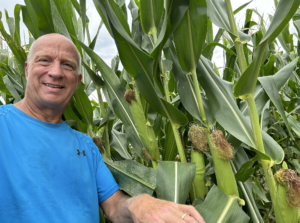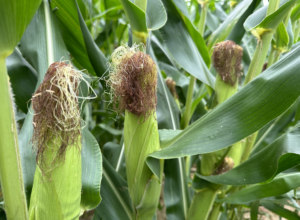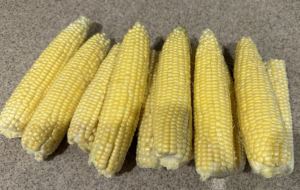Move over carbon credits, and make room for carbon intensity scores. That’s the sentiment of many in the ag industry. Launched with plenty of fanfare, and hailed by celebrities and politicians alike, carbon credits seemed to represent a modern-day gold rush. Yet we’re multiple years in, and adoption sits at about 1-3% of farmers. Why is that? For starters, farmers already employing the cultural practices required to qualify for carbon capture payments – no-till, cover crops, NUE, etc. – are ineligible to participate. Among those who are, lengthy contracts, significant investments in time and resources, and a lack of clarity serve as deterrents. Enter carbon intensity scores.
For farmers, CI is a carbon footprint score assigned to a bushel of grain. A CI score of 0 means that bushel is carbon neutral; today’s average CI score for corn is 29.1g GHG/MJ of ethanol energy. About 35% of all US-produced corn goes to ethanol. And ethanol reduces greenhouse gases by about 50% compared to other fuels. As part of the 2022 Inflation Reduction Act, biofuel makers can receive substantial tax credits – amounting for 5.4 cents per every point below the average – for sustainably produced grain. Farmers who utilize sustainable farming practices in growing corn (resulting in CI scores below 29.1) are poised to capture additional value from incentives paid by biofuel producers. For example, let’s say a farmer utilizes vertical tillage and uses a nitrogen inhibitor, and creates a CI score of 20. That results in over 48 cents of additional value in the form of a tax credit. Farmers who sell their corn to biofuel plants should get their CI baseline scores calculated. Companies such as my friends at Continuum Ag can provide this valuable service.
Even bigger opportunities for sustainably sourced crops are coming from consumer packaged goods (CPG) companies, who are looking to reduce their carbon footprint. Corporate policy directives, in line with investor appeasement and consumer value creation, is driving the market. Word has it the top 14 CPGs want to source 380 million acres of sustainably grown crops. To put that in perspective, the current total annual US row crop planted acreage – corn, soybeans, wheat and cotton – is 238 million acres. Walmart alone has pledged 50 million acres for sustainably produced crops. Similar opportunities exist for pasture lands and livestock producers. Sustainably grown crops are loosely defined, making the concept more appealing to growers. And unlike carbon capture programs, growers who are currently using sustainable practices are not only welcome, but desired. In any sustainably sourced cropping program, regenerative agriculture practices play a big role. So will be the use of biological and soil health products, and products that reduce the use of synthetic fertilizers. This creates a significant opportunity for humates.
My corn is still shedding pollen as it nears the end of its reproduction phase. Since this is the most critical time in a corn plant’s life, I wanted to mitigate any potential stress and encourage optimum grain fill. Last Wednesday, we applied Huma Gro® Breakout, Super Nitro, Super Phos, Lucky 7, X-Tend, Max Pak, Proud 3 and Crop Gard. It was likely our last shot with a ground sprayer, so we went all in. The corn was taller than the clearance of the sprayer, but the plants snapped right back over with no injury. I see that as a good sign of plant health. Fortunately, we have received about 4″ of rain during pollination.
While denting can be a welcomed sight among field corn growers – signaling the start of crop maturity – the same can’t be said for the delicacy known as corn on the cob. When selecting ears of sweet corn at a farmer’s market or supermarket (my wife refuses to stand anywhere near me during my highly discriminating selection process) here’s a tip: pull the husk back slightly and observe the kernels. They should be smooth and glossy. If you see dimples on the crowns of the kernels, don’t take it home. This means the ear is older and much of the sugars have been released from the kernels, so you’ll get a bland or starchy taste instead of a sweet taste. If your sweet corn looks like this (I grew this in my garden, the variety is called Incredible – and it is!) then you’ll be saying Bon Appetit!
Last week’s Gospel reading at my church had a strong farming theme. While the parable used by Jesus is intended to have far greater spiritual meaning, you can certainly make a connection to the importance of soil health. “A sower went out to sow. And as he sowed, some seed fell on the path, and birds came and ate it up. Some fell on rocky ground, where it had little soil. It sprang up at once because the soil was not deep, and when the sun rose it was scorched, and it withered for lack of roots. Some seed fell among thorns, and the thorns grew up and choked it. But some seed fell on rich soil, and produced fruit, a hundred or sixty or thirtyfold. Whoever has ears ought to hear.”
Related Posts

Proof of His Vision: The 1984 Humic Acid Study
Decades before humic acids became more understood in agriculture, Dr. Jordan G. Smith was already testing their impact on plant growth. This newly uncovered 1984 study, co-authored by Huma’s founder, validates a vision that still drives our mission today.

Depression Food: A Garden-Fresh Tribute to the Greatest Generation
A heartfelt reflection on a simple summer dish of homegrown vegetables, honoring the resilience, self-reliance, and enduring legacy of Fred's grandparents who lived through the Great Depression.

Microorganisms: The Living Engine of Soil—Part 2
In Part 2 of this series, we look at Plant-Microbial Interactions.




